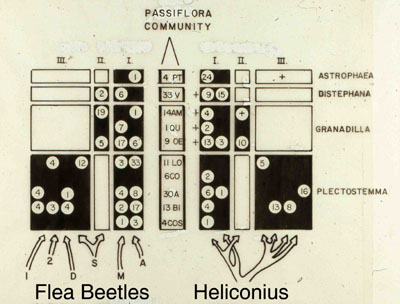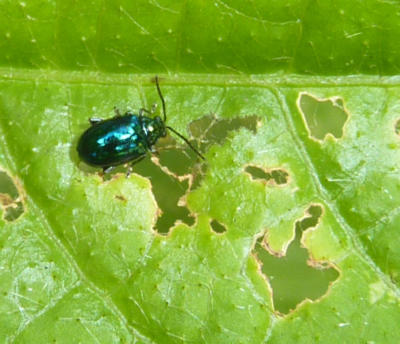Passiflora Flea Beetle Natural History
Historia Natural de Escarabajos Pulgas (Coleoptera:Alticini) que Comen Passiflora
Summary: As documented in Smiley 1982, I found a remarkable similarity between two communities of herbivores which feed at ground level on the new shoots of Passiflora vines: Heliconius butterflies and flea beetles (Chrysomelidae subfamily Alticini). This finding occurred at the La Selva Biological Station in northeastern Costa Rica, a protected primary rainforest with an extensive system of trails, roads, and experimentally manipulated areas as well as excellent support facilities. La Selva is characterized by relatively consistent rainfall and high humidity through the year. The Heliconius butterfly and Passiflora vine communities persist in relatively constant, low density populations, providing an excellent matrix for discovering a parallel flea beetle community. At least 8 flea beetle species are consistently found on Passiflora species during 3-5 sampling trips to La Selva, suggesting low-density, constant populations over a 35 year period. It is notable that the species are all brightly colored, like their Heliconius counterparts. Unfortunately, most of these colors fade to brown after death and so are not very useful when comparing with preserved specimens in museum collections.
Unfortunately we know very little about these colorful little insects. My goals in this study are to (1) continue to document host plant use by the flea beetles, including their larvae, (2) rear adults and larvae on different Passiflora vines to look at feeding tolerances and possible toxic feeding restrictions which might cause the parallel patterns of host plant use (3) find a way to look at cyanogenesis in both flea beetles and Heliconius (see HCN detoxication/metabolism hypothesis). In the photos, note that there seems to be two basic types of flea beetle: slender beetles whose elytra have parallel sides (Monomacra and Parchicola) and "rounder" species with domed elytra and relatively larger legs (Ptocadica and Pedilia).







continue reading HCN detoxication/metabolism hypothesis or skip to ongoing results, photos, etc.